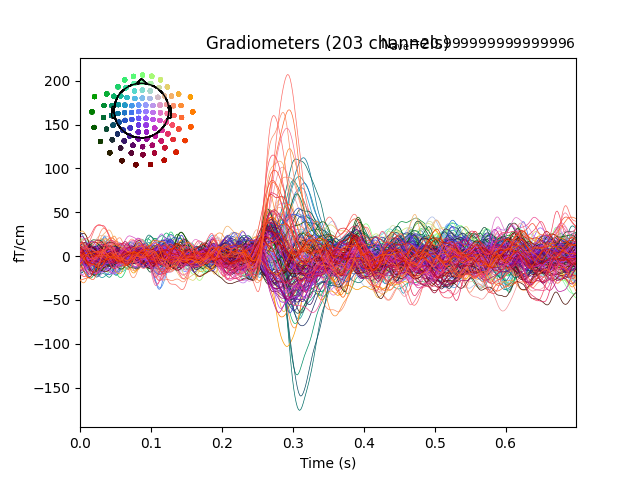Note
Go to the end to download the full example code.
Real-time evoked responses🔗
With a EpochsStream, we can build a real-time evoked response
visualization. This is useful to monitor the brain activity in real-time.
import uuid
import numpy as np
from matplotlib import pyplot as plt
from mne import EvokedArray, combine_evoked
from mne.io import read_raw_fif
from mne_lsl.datasets import sample
from mne_lsl.player import PlayerLSL
from mne_lsl.stream import EpochsStream, StreamLSL
from mne_lsl.utils.logs import logger
# dataset used in the example
fname = sample.data_path() / "mne-sample" / "sample_audvis_raw.fif"
raw = read_raw_fif(fname, preload=False).pick(("meg", "stim")).load_data()
First, we create a mock stream with mne_lsl.player.PlayerLSL from the sample
dataset and connect a StreamLSL to it. Then, we attach a
EpochsStream object to create epochs from the LSL stream.
The epochs will be created around the event ID 1 from the 'STI 014' channel.
Note
A chunk_size of 200 samples is used here to ensure stability and reliability
while building the documentation on the CI. In practice, a chunk_size of 200
samples is too large to represent a real-time application.
source_id = uuid.uuid4().hex
with PlayerLSL(
raw, chunk_size=200, name="real-time-evoked-example", source_id=source_id
):
stream = StreamLSL(bufsize=4, name="real-time-evoked-example", source_id=source_id)
stream.connect(acquisition_delay=0.1, processing_flags="all")
stream.info["bads"] = ["MEG 2443"]
stream.filter(None, 40, picks="grad")
epochs = EpochsStream(
stream,
bufsize=20,
event_id=1,
event_channels="STI 014",
tmin=-0.2,
tmax=0.5,
baseline=(None, 0),
picks="grad",
)
epochs.connect(acquisition_delay=0.1)
# create figure
if not plt.isinteractive():
plt.ion()
fig, ax = plt.subplots()
plt.show()
# start looking for epochs
n = 0 # number of epochs
evoked = None
while n < 20:
if epochs.n_new_epochs == 0:
continue # nothing new to do
logger.info("Got %s / %s new epochs.", epochs.n_new_epochs, n)
n += epochs.n_new_epochs
# get data and create evoked array
data = epochs.get_data(n_epochs=epochs.n_new_epochs)
new_evoked = EvokedArray(
np.average(data, axis=0), epochs.info, nave=data.shape[0]
)
evoked = (
new_evoked
if evoked is None
else combine_evoked([evoked, new_evoked], weights="nave")
)
evoked.nave = n # overwrite to avoid numerical approximation error
ax.clear()
evoked.plot(axes=ax, time_unit="s") # plot on current figure
fig.canvas.draw()
fig.canvas.flush_events()
# clean-up
epochs.disconnect()
stream.disconnect()

Total running time of the script: (0 minutes 57.295 seconds)
Estimated memory usage: 637 MB